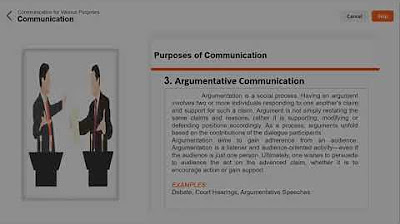Types of Delivery for Speeches and Public Speaking
Summary
TLDRIn this video, Alex Lyon explores four delivery styles for presentations: reading, memorizing, impromptu, and extemporaneous. Reading is discouraged due to lack of audience engagement. Memorizing can sound robotic. Impromptu is valuable for quick, unprepared speeches. Extemporaneous delivery, using an outline and speaking conversationally, is recommended for its adaptability and connection with the audience. Lyon encourages viewers to practice impromptu skills and adopt extemporaneous speaking for professional and personal growth.
Takeaways
- 🎓 **Reading**: Not recommended for presentations due to lack of audience engagement.
- 📜 **Memorizing**: Can sound robotic and lacks human connection, not ideal for most presentations.
- 💡 **Impromptu**: Valuable skill for quick, unprepared speeches, especially in professional settings.
- 📝 **Extemporaneous**: The preferred delivery style, combines preparation with a conversational tone.
- 👥 **Engagement**: Reading and memorizing tend to have low audience engagement.
- 🏆 **Skill Development**: Impromptu speaking is a skill worth developing for spontaneous professional demands.
- 📈 **Adaptability**: Extemporaneous speaking allows for better audience adaptation and connection.
- 📊 **Occasions**: Reading might be suitable for very formal and short speeches like graduations or weddings.
- 📋 **Note Usage**: Extemporaneous speakers use outlines, not scripts, to maintain a conversational flow.
- 🌟 **Recommendation**: Extemporaneous delivery is the recommended approach for most presentations.
Q & A
What are the four types of delivery styles discussed in the video?
-The four types of delivery styles discussed are reading, memorizing, impromptu, and extemporaneous.
Why does the presenter not recommend reading your presentation word-for-word?
-The presenter does not recommend reading word-for-word because it generally leads to a lack of audience engagement and can come across as unengaging.
In what situations might reading your presentation be appropriate?
-Reading might be appropriate in extremely formal situations such as a graduation ceremony or giving a toast at a wedding, or when the presentation or speech is very short.
What is the difference between reading and memorizing a presentation?
-With memorizing, you have practiced the presentation so much that you can deliver it word-for-word without looking at notes, whereas reading involves looking at a script or notes while delivering the presentation.
Why might memorizing a presentation sound wooden or robotic?
-Memorizing a presentation can sound wooden or robotic because it often lacks the natural flow and emotion that comes with spontaneous speech, leading to a less human and more mechanical delivery.
What is the impromptu style of delivery and why is it useful to practice?
-The impromptu style involves speaking with very little preparation and minimal notes. It's useful to practice because it develops the ability to think on your feet and respond effectively in situations where you are asked to speak with short notice.
How does the presenter define the extemporaneous delivery style?
-The extemporaneous style involves speaking from an outline that has been researched and practiced, but delivered in a conversational manner, allowing for natural expression and adaptation to the audience.
What is the main benefit of using the extemporaneous delivery style?
-The main benefit is the ability to connect with the audience through eye contact and adapt to their nonverbal cues, making the presentation more engaging and interactive.
Why is the extemporaneous delivery style considered scalable?
-It is scalable because it can be used effectively in various settings such as professional, community, and academic environments, and it can be adapted as needed for different audiences and situations.
What does the presenter suggest as the first option for delivery style?
-The presenter suggests the extemporaneous approach as the first option for delivery style due to its versatility and effectiveness in engaging with the audience.
What question does the presenter pose to the viewers at the end of the video?
-The presenter asks viewers to share their favorite or go-to approach to delivery style and invites them to comment on this in the section below the video.
Outlines

This section is available to paid users only. Please upgrade to access this part.
Upgrade NowMindmap

This section is available to paid users only. Please upgrade to access this part.
Upgrade NowKeywords

This section is available to paid users only. Please upgrade to access this part.
Upgrade NowHighlights

This section is available to paid users only. Please upgrade to access this part.
Upgrade NowTranscripts

This section is available to paid users only. Please upgrade to access this part.
Upgrade NowBrowse More Related Video

PURPOSIVE COMMUNICATION CHAPTER 6: COMMUNICATION FOR VARIOUS PURPOSES

How to Deliver an Extemporaneous Presentation or Speech

Lecture 8 Speech Making Types

Extemporaneous vs Impromptu Speech Delivery and When To Use Them

Types of speech according to delivery| Impromptu & Extemporaneous Speeches | Oral Communication

Four Types of Speech Delivery Impromptu, Extemporaneous, Manuscript Memorized Video Lesson Tr
5.0 / 5 (0 votes)